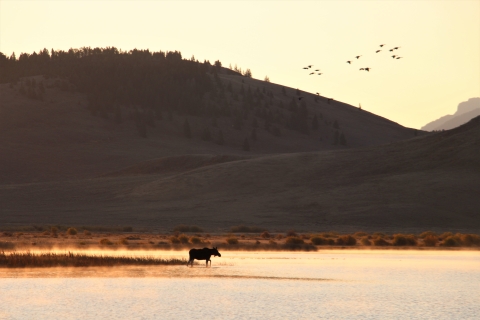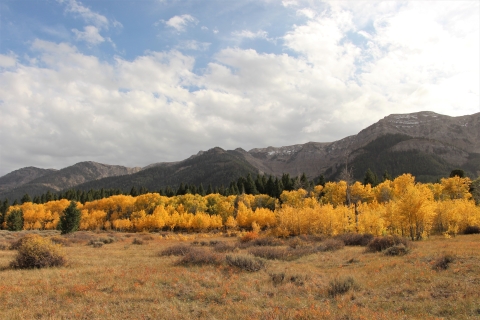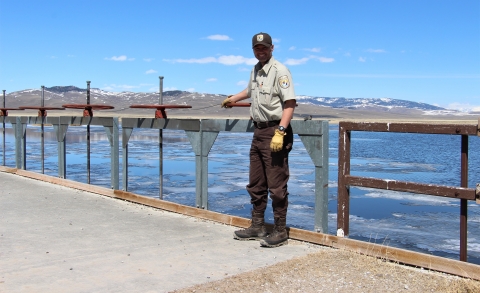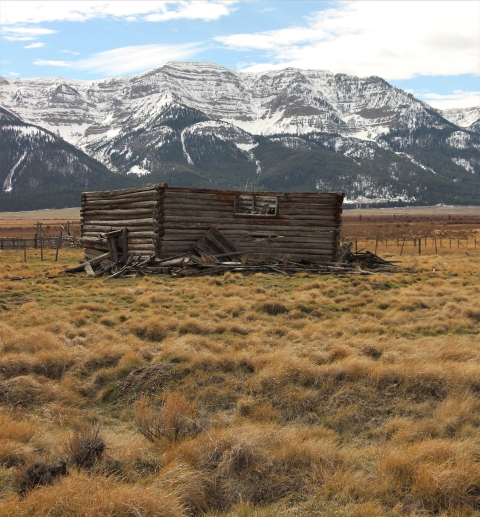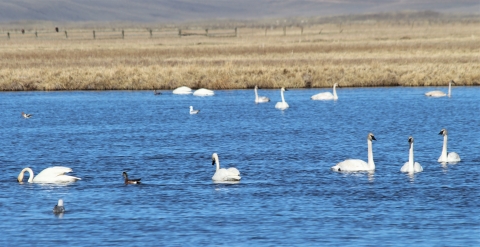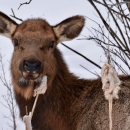About Us
Red Rock Lakes National Wildlife Refuge has often been called the most beautiful National Wildlife Refuge in the United States. The rugged Centennial Mountains, rising roughly 10,000 feet and running from east to west, provide a dramatic backdrop for this extremely remote Refuge in Southwest Montana's Centennial Valley.
The Refuge encompasses primarily high mountain and high elevation wetland- riparian riparian
Definition of riparian habitat or riparian areas.
Learn more about riparian habitat - the largest in the Greater Yellowstone Ecosystem, and is located near the headwaters of the Missouri River. Numerous creeks flow into the Refuge creating Upper Red Rock Lake, the River Marsh, and Lower Red Rock Lake. The snows of winter replenish the Refuge’s lakes and wetlands that provide secluded habitat for many waterfowl, shorebirds, and wetland birds including trumpeter swans, white-faced ibis, and black-crowned night herons. The Refuge also includes wet meadows, riparian creek edges, willow fen, cool season grasslands, sage-steppe, and mountain forest habitats. This diversity provides habitat for other species such as sandhill cranes, long-billed curlews, bald and golden eagles, hawks, warblers, moose, elk, badgers, bears, wolves, mountain lions, martens, pronghorn, and native fish such as Arctic grayling and westslope cutthroat trout.
Red Rock Lakes Wilderness
Over 60% of the Refuge is designated as wilderness. Some important information about the Refuge wilderness:
- Established 1976
- 32,350 acres
- Why Wilderness? The Wilderness Act of 1964 created the National Wilderness Preservation System "in order to assure that an increasing population, accompanied by expanding settlement and growing mechanization, does not occupy and modify all areas in the United States, and its possession, leaving no lands designated for preservation and protection in their natural condition..."
- For more information about Red Rock Lakes Wilderness, visit: Wilderness Connect
Our Mission
Refuge management focuses on maintaining natural areas and wilderness values. In this context, management first provides habitat for migratory birds and endangered species followed closely with an emphasis on native wildlife and sensitive species. Water is managed to provide nesting habitat for swans, waterfowl and fisheries. Much of the Refuge already has substantial natural habitat diversity; management seeks to enhance those natural area values where appropriate and sustainably maintain them utilizing natural processes.
The majestic Centennial Valley of southwest Montana is an expansive mosaic of high elevation wetlands, cool season grasslands, sage-steppe, and mountain forests framed by dramatic mountain peaks. Partnerships and conservation programs have helped the valley to maintain its biological integrity and continue to be a working landscape that remains largely undeveloped.
To this end, Red Rock Lakes National Wildlife Refuge is a conservation leader in the Centennial Valley working to maintain and restore natural processes to create and sustain native habitat for migratory and resident fish and wildlife. Visitors can expect to experience a sense of solitude and wildness while on the Refuge and in the valley.
Our History
Establishment
On April 22, 1935, President Franklin D. Roosevelt established the Red Rock Lakes Migratory Waterfowl Refuge, which was renamed the Red Rock Lakes National Wildlife Refuge in 1961. Roosevelt’s Executive Order 7023 established Red Rock Lakes “as a refuge and breeding ground for wild birds and animals.”
Since the Refuge boundary was established, the U.S. Fish & Wildlife Service has acquired lands from willing landowners or by receiving donations. The Service currently owns 53,418 acres within the approved boundary, with designated wilderness consisting of 32,350 acres. The Refuge also manages conservation easements totaling 23,806 acres.
Historical Background
The Centennial Valley was well known to the Shoshone-Bannock, Nez Perce, and other nomadic tribes as a favored travel route between the headwaters of the Big Hole River and the Yellowstone country. The wide stretches of uninterrupted native grasslands provided grazing bison with ample feed and served as their traditional summer range. Settlement by Euro-Americans did not occur until 1876. Herds of livestock were driven into the valley and homesteads sprang up in scattered locations. In the early days, market hunting for waterfowl and big game brought some revenue to local residents, but most settlers concentrated on livestock and sporadic lumbering. The long winters, great distances to market, and small land parcels combined to make subsistence difficult. Few survived the depression of the 1930s.
The Monida-Yellowstone stagecoach line passed through Red Rock Lakes NWR on what is now South Valley Road and Red Rock Pass Road. Originally established in 1898, the four-horse drawn stagecoaches carried passengers between the railroad station in Monida and West Yellowstone and Henry's Lake. A note from the Madisonian newspaper from August 28, 1902, notes that the stage line "has carried over 12,000 passengers to the National Park this season and are having all they can handle every day. They have had to put on extra teams to accommodate the large number of tourists." The grand era of stagecoach travel in West Yellowstone ended in 1917 when touring cars replaced the stages. A plaque near Shambow Pond commemorates the site of the half-way house used by stagecoach travelers on their way west. Trumpeter swans and other waterfowl can now be seen on Shambow Pond.
Red Rock Lakes National Wildlife Refuge invites you to view and enjoy the nearby historic buildings and artifacts. Please be advised that altering, defacing, or removal of any historical materials from Refuge property is prohibited. Shambow Pond and the immediate area surrounding it is closed to all public use and access.
Other Facilities in this Complex
Red Rock Lakes National Wildlife Refuge is part of the Centennial-Jackson Valleys National Wildlife Refuge Complex, which also includes the National Elk Refuge in Jackson, WY.



